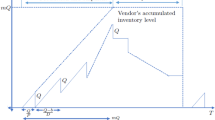Abstract
This paper investigates a generalized lead time distribution with a variable backordering rate in a two-echelon supply chain system. The vendor produces a single product and delivers to the buyer in equal sized batches. The delivery lead time follows a generalized stochastic variable. Shortages are allowed to occur and backordered partially. The backorder rate depends on the demand on stock-out period. Based on this notion, we formulate a mixed integer non-linear cost function which needs to be minimized with respect to reorder point, number of deliveries and lot size from the vendor to the buyer, to operate cooperatively in the integrated model. Analytically we proved the convexity of the generalized lead time distribution cost function with respect to the control parameters. Further, the uniqueness of optimality has been proved. To validate the proposed model, uniform, exponential and normal distributed lead times are presented in numerical example section. Sensitivity analysis also performed to the values of the parameters.





Similar content being viewed by others
References
Ben-Daya M, Raouf A (1994) Inventory models involving lead time as a decision variable. J Oper Res Soc 45(5):579–582
Cárdenas-Barrón LE, Wee HM, Blos MF (2011) Solving the vendor–buyer integrated inventory system with arithmetic–geometric inequality. Math Comput Model 53(5–6):991–997
Cárdenas-Barrón LE, Teng JT, Treviño-Garza G, Wee HM, Lou KR (2012) An improved algorithm and solution on an integrated production-inventory model in a three-layer supply chain. Int J Prod Econ 136(2):384–388
Chung CJ, Wee HM (2008) An integrated production-inventory deteriorating model for pricing policy considering imperfect production, inspection planning and warranty-period- and stock-level-dependant demand. Int J Syst Sci 39(8):823–837
Fujiwara O, Sedarage D (1997) An optimal \((Q, r)\) policy for a multipart assembly system under stochastic part procurement lead times. Eur J Oper Res 100(3):550–556
Goyal SK (1977) An integrated inventory model for a single supplier-single customer problem. Int J Prod Res 15(1):107–111
He XJ, Kim JG, Hayya JC (2005) The cost of lead time variability: the case of the exponential distribution. Int J Prod Econ 97(2):130–142
Hossain MSJ, Ohaiba MM, Sarker BR (2017) An optimal vendor–buyer cooperative policy under generalized lead-time distribution with penalty cost for delivery lateness. Int J Prod Econ 188:50–62
Hoque MA (2013) A vendor–buyer integrated production-inventory model with normal distribution of lead time. Int J Prod Econ 144(2):409–417
Huang CK (2004) An optimal policy for a single-vendor single-buyer integrated production inventory problem with process unreliability consideration. Int J Prod Econ 91(1):91–98
Jokar MRA, Sajadieh MS (2008) Determining optimal number of suppliers in a multiple sourcing model under stochastic lead times. J Ind Syst Eng 2(1):16–27
Lee WC, Wu JW, Lei CL (2007) Optimal inventory policy involving back-order discounts and variable lead time demand. Int J Adv Manuf Technol 34(9):958–967
Lee W, Wang SP, Chen WC (2017) Forward and backward stocking policies for a two-level supply chain with consignment stock agreement and stock-dependent demand. Eur J Oper Res 256(3):830–840
Liberatore MJ (1977) Planning horizons for a stochastic lead-time inventory model. Oper Res 25(6):977–988
Lin YJ (2009) An integrated vendor–buyer inventory model with backorder price discount and effective investment to reduce ordering cost. Comput Ind Eng 56(4):1597–1606
Lin HJ (2016) Investing in lead-time variability reduction in a collaborative vendor–buyer supply chain model with stochastic lead time. Comput Oper Res 72:43–49
Nasri F, Affisco JF, Javad Paknejad M (1990) Setup cost reduction in an inventory model with finite-range stochastic lead times. Int J Prod Res 28(1):199–212
Ouyang LY, Wu KS, Ho CH (2007) An integrated vendor–buyer inventory model with quality improvement and lead time reduction. Int J Prod Econ 108(1):349–358
Paknejad J, Nasri F, Affisco JF (2005) Quality improvement in an inventory model with finite-range stochastic lead times. Adv Decis Sci 2005(3):177–189
Pan JCH, Yang JS (2002) A study of an integrated inventory with controllable lead time. Int J Prod Res 40(5):1263–1273
Sajadieh MS, Akbari Jokar MR (2009) An integrated vendor–buyer cooperative model under stochastic supply lead-time. Int J Adv Manuf Technol 41(9):1043–1050
Sajadieh MS, Jokar MRA, Modarres M (2009) Developing a coordinated vendor–buyer model in two-stage supply chains with stochastic lead-times. Comput Oper Res 36(8):2484–2489
Sajadieh MS, Thorstenson A, Jokar MRA (2010) An integrated vendor–buyer model with stock-dependent demand. Transp Res Part E Logist Transp Rev 46(6):963–974
Shu MH, Huang JC, Fu YC (2015) A production-delivery lot sizing policy with stochastic delivery time and in consideration of transportation cost. Appl Math Model 39(10):2981–2993
Sphicas GP, Nasri F (1984) An inventory model with finite-range stochastic lead times. Nav Res Logist 31(4):609–616
Tersine RJ (1982) Principles of inventory and materials management. North Holland, Amsterdam
Wangsa ID, Wee HM (2017) Impact of lead time reduction and fuel consumption on a two-echelon supply chain inventory with a subsidised price and pick-up policy. Int J Integr Supply Manag 11(2–3):264–289
Wu JW, Lee WC, Tsai HY (2007) Computational algorithmic procedure of optimal inventory policy involving a negative exponential crashing cost and variable lead time demand. Appl Math Comput 184(2):798–808
Yang MF (2010) Supply chain integrated inventory model with present value and dependent crashing cost is polynomial. Math Comput Model 51(5):802–809
Yano CA (1987) Stochastic leadtimes in two-level assembly systems. IIE Trans 19(4):371–378
Acknowledgements
The work of the authors are supported by Department of Science and Technology-Science and Engineering Research Board (DST-SERB), Government of India, New Delhi, under the Grant Number DST-SERB/SR/S4/MS: 814/13-Dated 24.04.2014.
Author information
Authors and Affiliations
Corresponding author
Additional information
Publisher’s Note
Springer Nature remains neutral with regard to jurisdictional claims in published maps and institutional affiliations.
Rights and permissions
About this article
Cite this article
Ganesh Kumar, M., Uthayakumar, R. A two-echelon integrated inventory model under generalized lead time distribution with variable backordering rate. Int J Syst Assur Eng Manag 10, 552–562 (2019). https://doi.org/10.1007/s13198-019-00769-x
Received:
Revised:
Published:
Issue Date:
DOI: https://doi.org/10.1007/s13198-019-00769-x




